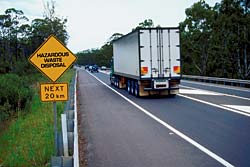Our e-Manifest Destiny

As the rest of our society goes increasingly paperless, it’s inevitable that our nation’s hazardous waste tracking system also will head in the same direction.
Under the Resource Conservation and Recovery Act, the hazardous waste manifest system is a set of forms, reports, and procedures designed to seamlessly track hazardous waste from the time it leaves the generator facility where it is produced, typically as a byproduct of the facility’s manufacturing processes, until it reaches the off-site waste management facility that then stores, treats, or disposes of the hazardous waste.
The key component of the system is the uniform hazardous waste manifest, which is a form initially prepared by the waste generator. Currently, the manifest is a paper document containing multiple copies of a single form. When completed, it contains information on the type and quantity of waste being transported, instructions for handling the waste, and signature lines for all parties involved in the disposal process. Both the U.S. Environmental Protection Agency (EPA) and the U.S. Department of Transportation require the manifest. Each party that handles the waste signs the manifest and retains a copy. EPA estimates that about 139,000 businesses in approximately 45 industries ship about 12 million tons of hazardous waste annually.
On April 8, EPA issued a notice of data availability (71 Federal Register 19,842) about anticipated legislation concerning an electronic manifest system. EPA notice stated that “considerable funds” would be required to start up and maintain a centralized e-manifest system. According to EPA, initial start-up costs are estimated at $2 million to $7 million, with up to $3.2 million per year in operation and maintenance costs. Industry and state governments would have their own costs for launching and operating an e-manifest system. Yet, EPA officials predict that moving from paper forms to an electronic system is expected to save up to $103 million per year.
As a necessary step in converting the paper manifest system to an electronic one, EPA began requiring on September 5 that hazardous waste generators and haulers start using the agency’s standardized manifest form to keep track of shipments. According to the agency, the new form eliminates or reduces many of the variables in state requirements. It allows multistate waste handlers to register and use their own manifest forms everywhere they do business. Users must obtain the forms, which each have a unique, pre-printed manifest tracking number, from an EPA-approved supplier. Not using the new EPA manifest would constitute a violation of federal law. Whether a waste handler would face penalties, however, would be up to the discretion of the enforcement personnel in the states. For more information, contact Richard LaShier in EPA’s Office of Solid Waste at (703) 308-8796 or Bryan Groce, also at the same office, at (703) 308-8750.
On September 7, Sen. John Thune, R-S.D., introduced before the U.S. Senate the proposed bill entitled “The Hazardous Waste Electronic Manifest Establishment Act” (S.387), which would create a revolving fund at the U.S. Treasury Department to be used to pay costs incurred in developing, maintaining, and upgrading the system. The piece of legislation, which amends the Solid Waste Disposal Act, requires the electronic system to be in operation three years after the bill is enacted. The bill would authorize EPA to select a vendor to put together an electronic system that would allow states and private industry to transition to using the new e-manifests.
According to the bill, waste handlers choosing to use the computerized system rather than paper forms would pay user fees that would reimburse the vendor, as well as pay EPA’s overhead costs. The service fees would cover materials and supplies, contracting and consulting, information technology and management, fee collection, investing any unused services fees, and accounting and personnel costs. To check the current status of the bill, go to the Library of Congress’ Web site.
The bill appears to have the blessing of many in industry. In September, Scott Slesinger, vice president for governmental affairs at the Environmental Technology Council (ETC), said that his organization fully endorses going to an electronic system. ETC represents environmental firms that recycle, treat, or dispose of hazardous waste and companies involved in the clean up of sites contaminated with hazardous waste.
“I believe the bill will pass in the waning days of this Congress,” he said. “We believe it is not controversial legislation.”
The move to electronic manifest is a positive development because it will further strengthen the system that has been set up to guarantee that hazardous waste doesn’t end up at sham recycling facilities or illegal dump sites.
This editorial originally appeared in the November/December 2006 issue of Environmental
Protection, Vol. 17, No. 9.
This article originally appeared in the 11/01/2006 issue of Environmental Protection.